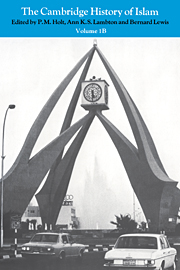Introduction
Published online by Cambridge University Press: 28 March 2008
Summary
A reader taking up a work entitled The Cambridge history of Islam may reasonably ask, ‘What is Islam? In what sense is Islam an appropriate field for historical enquiry?’ Primarily, of course, Islam is, like Christianity, a religion, the antecedents, origin and development of which may, without prejudice to its transcendental aspects, be a legitimate concern of historians. Religious history in the narrow sense is not, however, the only, or even the main, concern of the contributors to these volumes. For the faith of Islam has, again like Christianity, been a great synthesizing agent. From its earliest days it displayed features of kinship with the earlier monotheisms of Judaism and Christianity. Implanted in the former provinces of the Byzantine and Sasanian empires, it was compelled to maintain and define its autonomy against older and more developed faiths. Like Judaism and Christianity before it, it met the challenge of Greek philosophy, and adopted the conceptual and logical tools of this opponent to expand, to deepen, and to render articulate its self-consciousness. In this connexion, the first three centuries of Islam, like the first three centuries of Christianity, were critical for establishing the norms of belief and practice, and for embodying them in a tradition which was, or which purported to be, historical.
The Islamic synthesis did not stop at this stage. The external frontier of Islam has continued to move until our own day. For the most part, this movement has been one of expansion—into Central Asia, into the Indian sub-continent and south-east Asia, and into trans-Saharan Africa—but there have also been phases of retreat and withdrawal, notably in Spain, and in central and south-eastern Europe.
- Type
- Chapter
- Information
- The Cambridge History of Islam , pp. vii - xivPublisher: Cambridge University PressPrint publication year: 1977



